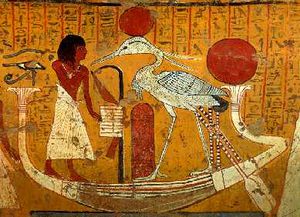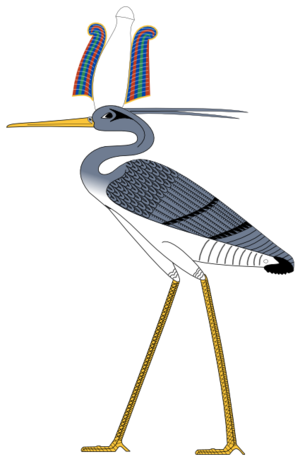「ベンヌ」の版間の差分
(→神話) |
(→描写) |
||
| 19行目: | 19行目: | ||
== 描写 == | == 描写 == | ||
| − | 古王国時代<ref>紀元前2686年頃 - 紀元前2185年前後。エジプト第3~第6王朝にかけて。</ref> | + | 古王国時代<ref>紀元前2686年頃 - 紀元前2185年前後。エジプト第3~第6王朝にかけて。</ref>のピラミッド・テキストには、アトゥムのシンボルとして「bnw」が登場するが、これはベンヌの原型であった可能性がある。この言葉には鳥のヒエログリフが使われているが、それは間違いなくサギではなく、小さなさえずる鳥である。 |
| − | + | The old 'Woerterbuch der Aegyptische Sprache' surmised that this small singing bird might have been a [[Western yellow wagtail|Yellow Wagtail]] ('Motacilla flava', but no clear reason is given. <ref name="Hart"/> However, the same bird used in the spelling of a word 'bn.t' in a painted limestone relief wall fragment from the suntemple of the Vth Dynasty king [[Nyuserre Ini|Niuserre]] from the Old Kingdom, now in the Aegypisches Museum at Berlin (inv.nr. Aeg.Mus. 20038-20039), clearly shows traces of blue-grey paint on much of the body of this bird-sign, so that a different bird species was definitely meant. Shape and colour seem to point rather to a (Mediterranean) [[Common kingfisher|Kingfisher]] (Alcedo atthis) for whom, however, another name was in use: 'hn.t<y'= lit. 'the one of the canal'. Traces of orange(brown)colouring existing on and also outside the chiseled glyph did originally not belong to this particular bird sign. They are caused by natural stains in the white limestone, as the higher lying layer of blue paint on the bird shows as well. The advantage of such bird identification might be, that a Kingfisher flying lowly over watery surfaces and shrieking loudly would be a reasonable mythical example for the creator deity Atum of Heliopolis as having risen from the first dark waters, called Nun, in order to start his creation of the world. If so, this Kingfisher 'bnw' or 'bn.t' is a good match for the mythical and cultic Nilegoose (Eg. 'smn')of the creator deity Amun in later periods, imagined to having been honking loudly in the primeval dark above the still waters in order to bring forth all creation by its voice.{{cn|date=March 2021}} | |
[[New Kingdom of Egypt|New Kingdom]] artwork shows Bennu as a huge [[grey heron]] with a long beak and a two-feathered crest. Sometimes Bennu is depicted as perched on a [[benben]] stone (representing Ra and the name of the top stone of a pyramid) or in a willow tree (representing Osiris). Because of the connection with Osiris, Bennu sometimes wears the [[Atef]] crown,<ref name="Wilkinson"/> instead of the solar disk. | [[New Kingdom of Egypt|New Kingdom]] artwork shows Bennu as a huge [[grey heron]] with a long beak and a two-feathered crest. Sometimes Bennu is depicted as perched on a [[benben]] stone (representing Ra and the name of the top stone of a pyramid) or in a willow tree (representing Osiris). Because of the connection with Osiris, Bennu sometimes wears the [[Atef]] crown,<ref name="Wilkinson"/> instead of the solar disk. | ||
2022年3月27日 (日) 22:21時点における版
ベンヌ(Bennu、/bɛnu/)[1]、ベヌウ、ベヌとは、エジプト神話に伝わる不死の霊鳥。ベンヌは、エジプト神話で太陽、創造、再生と結びついている。ベンヌはギリシャ神話で発展した不死鳥伝説の原型かもしれない。
目次
概要
エジプト語の「立ち上がる者(ウェベン)」が由来とされる。「鮮やかに舞い上がり、そして光り輝く者」、「ラーの魂」、「自ら生まれた者」または、「記念祭の主」などの肩書きを持つ。
主に長い嘴をした黄金色に輝く青鷺(アオサギ)で、他に爪長鶺鴒(ツメナガセキレイ)、赤と金の羽がある鷲(ワシ)とも言う。稀なケースでは、鷺の頭をした人間の姿で表された。
太陽信仰と関連付けられたイシェドの木(ギリシアでは、ペルセア。)にとまる聖鳥。アトゥム、ラー、オシリスの魂であるとも考えられている。
神話
エジプト神話では、ベンヌは自らを創造した存在で、世界の創造に一役買ったとされている。ベンヌはラーのバー(魂)であり、アトゥムの創造的な行動を可能にしたと言われている[2]。アトゥムあるいは、ラーは、天地創造の前、この世の始めに混沌または、原初の海ヌンからベンヌの姿で(自生的に)誕生し、ヌンの水の上を飛び、原初の丘「タァ・セネン」もしくは、「ベンベン」の上に舞い降りたという。あるいは、原初の海に沈んでいた太陽(の卵)が原初の丘に揚がった時にベンヌが太陽を抱いて暖めて孵化させたともされる。なお、この原初の丘を神格化したものがタテネンである。この世の最初に誕生した鳥であるベンヌの鳴き声が、天地創造の本質を決定する呼び声となり、この世の時間が開始されたともされる。
太陽と同じように毎朝生まれ夕暮れと共に死んで次の朝に再び生き返るとされた。ベンヌは再生の象徴であり、生と死を繰り返すことからオシリスとも関連付けられた[3]。
ベンヌの称号には「自ら存在するようになった者[2]」、「ジュビレ(Jubilee)の主」というものがあり、これはベンヌが太陽のように定期的に自己更新していると考えられていたことに由来する[3]。その名前は、「輝きを増す」「輝く」という意味のエジプト語の動詞「wbn」に関連している[2]。
ホルス及びギリシアのフェニックスのモデルとも言われる。
描写
古王国時代[4]のピラミッド・テキストには、アトゥムのシンボルとして「bnw」が登場するが、これはベンヌの原型であった可能性がある。この言葉には鳥のヒエログリフが使われているが、それは間違いなくサギではなく、小さなさえずる鳥である。
The old 'Woerterbuch der Aegyptische Sprache' surmised that this small singing bird might have been a Yellow Wagtail ('Motacilla flava', but no clear reason is given. [2] However, the same bird used in the spelling of a word 'bn.t' in a painted limestone relief wall fragment from the suntemple of the Vth Dynasty king Niuserre from the Old Kingdom, now in the Aegypisches Museum at Berlin (inv.nr. Aeg.Mus. 20038-20039), clearly shows traces of blue-grey paint on much of the body of this bird-sign, so that a different bird species was definitely meant. Shape and colour seem to point rather to a (Mediterranean) Kingfisher (Alcedo atthis) for whom, however, another name was in use: 'hn.t<y'= lit. 'the one of the canal'. Traces of orange(brown)colouring existing on and also outside the chiseled glyph did originally not belong to this particular bird sign. They are caused by natural stains in the white limestone, as the higher lying layer of blue paint on the bird shows as well. The advantage of such bird identification might be, that a Kingfisher flying lowly over watery surfaces and shrieking loudly would be a reasonable mythical example for the creator deity Atum of Heliopolis as having risen from the first dark waters, called Nun, in order to start his creation of the world. If so, this Kingfisher 'bnw' or 'bn.t' is a good match for the mythical and cultic Nilegoose (Eg. 'smn')of the creator deity Amun in later periods, imagined to having been honking loudly in the primeval dark above the still waters in order to bring forth all creation by its voice.テンプレート:Cn
New Kingdom artwork shows Bennu as a huge grey heron with a long beak and a two-feathered crest. Sometimes Bennu is depicted as perched on a benben stone (representing Ra and the name of the top stone of a pyramid) or in a willow tree (representing Osiris). Because of the connection with Osiris, Bennu sometimes wears the Atef crown,[3] instead of the solar disk.
Possible animal model
In comparatively recent times, a large species of heron, now extinct, lived on the Arabian Peninsula. It shares many characteristics with Bennu. It may have been the animal after which Bennu was modeled by the ancient Egyptians during the New Kingdom.[5]
Worship

Like Atum and Ra, the Bennu was probably worshipped in their cult center at Heliopolis.[3] The deity also appears on funerary scarab amulets as a symbol of rebirth.[2]
Connection with the Greek phoenix
The Greek historian Herodotus, writing about Egyptian customs and traditions in the fifth century BC, wrote that the people at Heliopolis described the "phoenix" to him. They said it lived for 500 years before dying, resuscitating, building a funerary egg with myrrh for the paternal corpse, and carrying it to the temple of the Sun at Heliopolis.[6] His description of the phoenix likens it to an eagle with red and gold plumage, reminiscent of the sun.[3]
Long after Herodotus, the theme ultimately associated with the Greek phoenix, with the fire, pyre, and ashes of the dying bird developed in Greek traditions.
The name, "phoenix", could be derived from "Bennu" and its rebirth and connections with the sun resemble the beliefs about Bennu, however, Egyptian sources do not mention a death of the deity.[2]
Chosen as scientific name of the bird
Remains of a giant, human-sized heron species, thought to have gone extinct around 1500 BC, have been discovered in the United Arab Emirates.[7] That species may have been the animal model for the deity, Bennu, so archaeologist Dr. Ella Hoch from the Geological Museum at Copenhagen University named it the Bennu heron (Ardea bennuides).[8]
派生
2013年5月1日には、NASAの小惑星探査機オサイリス・レックスが探査を行う小惑星(101955)_1999_RQ36に公募によって、このベンヌと言う名前が与えられたことが発表された。
参考文献
参照
- ↑ dict.com, Bennu
- ↑ 2.0 2.1 2.2 2.3 2.4 2.5 Hart , George , The Routledge Dictionary of Egyptian Gods and Goddesses , Second , New York , Routledge , 2005 , pages:48–49 , isbn:0-415-34495-6
- ↑ 3.0 3.1 3.2 3.3 3.4 Wilkinson , Richard H. , The Complete Gods and Goddesses of Ancient Egypt , London , Thames & Hudson , 2003 , 212 , isbn:0-500-05120-8 , url-access:registration , https://archive.org/details/completegodsgodd00wilk_0/page/212
- ↑ 紀元前2686年頃 - 紀元前2185年前後。エジプト第3~第6王朝にかけて。
- ↑ テンプレート:Cite conference
- ↑ テンプレート:Cite journal
- ↑ WONDERS OF THE UNITED ARAB EMIRATES.{{{date}}} - via {{{via}}}.
- ↑ GIANT BIRDS FROM THE TOMBS OF THE PHARAOHS.31 May 2016 - via {{{via}}}.
